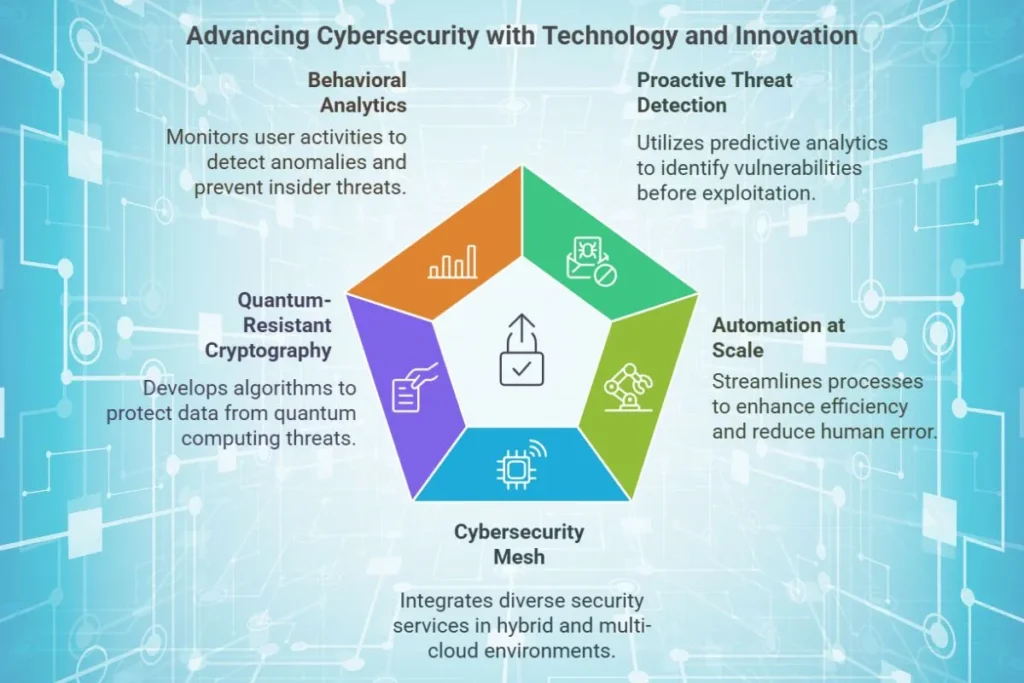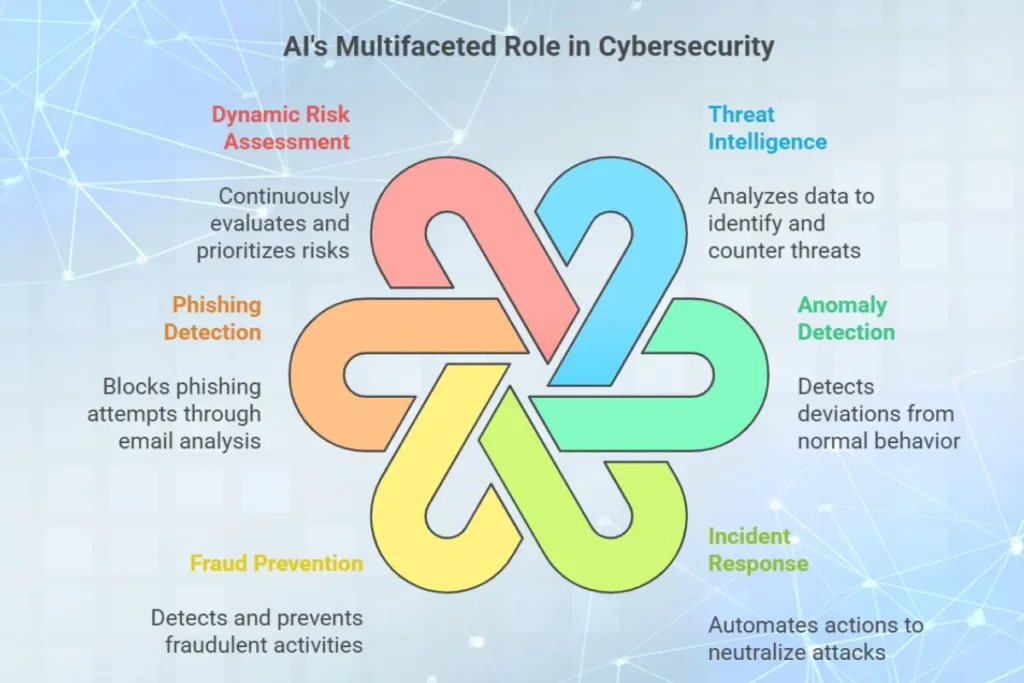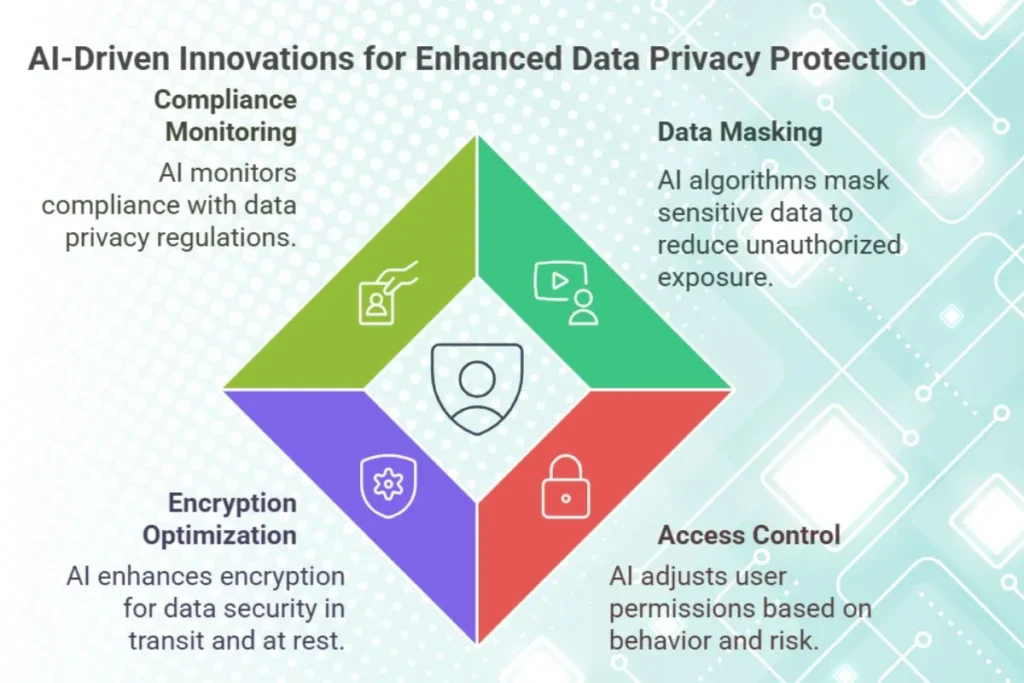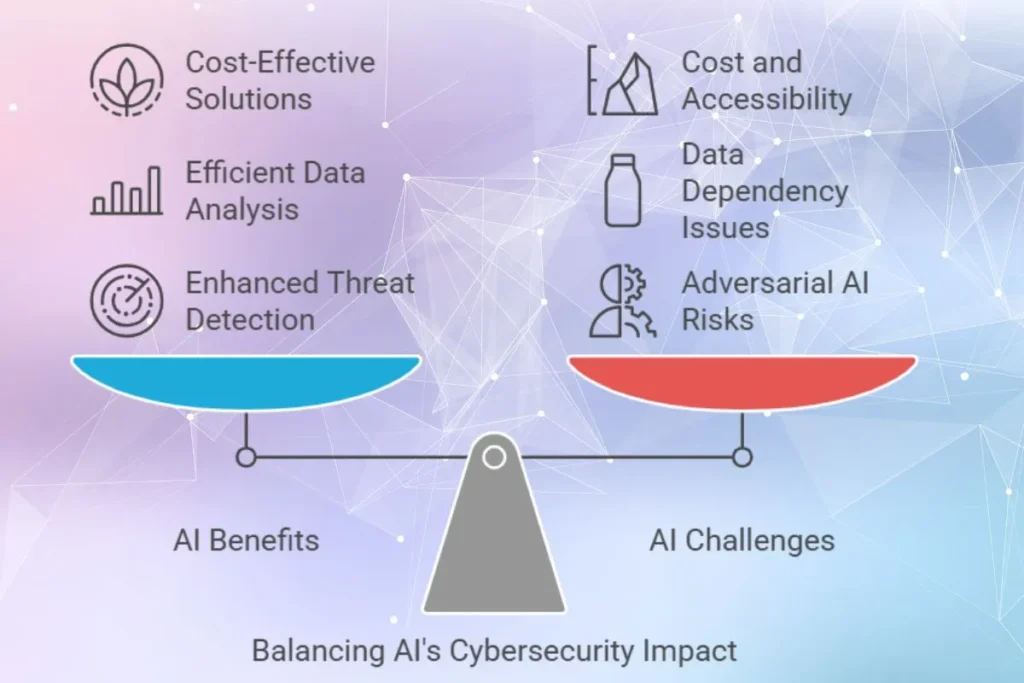Day by day the use of digital technology is increasing, and the challenges of securing sensitive information and systems are getting more complex. Cybersecurity is changing and becoming more advanced to handle increasingly advanced cyber threats. Artificial Intelligence (AI) has came out as a important force in this evolution, which offers advanced tools and techniques to identify, prevent and respond to cyberattacks. This is how AI helps cybersecurity.
In this blog article, we will discuss what is the future of cybersecurity, and the role of AI in cybersecurity. Also we shall learn how AI cybersecurity works and how AI is shaping a safer digital environment for tomorrow.
The Future of Cybersecurity
The future of cybersecurity will be defined by new technologies, adaptive strategies and the seamless integration of AI. Following are the main trends that are shaping the future of cybersecurity:
1. Proactive Threat Detection
Traditional methods generally react to attacks after they occur. The future lies in proactive threat detection using predictive analytics and machine learning to identify vulnerabilities before they are exploited. This approach reduces risks and minimizes damage.
2. Automation at Scale
Automation is set to streamline processes such as threat hunting, incident response and system patching. Automated tools reduce human error, enhance efficiency and enable faster responses to threats, even in large scale systems.
3. Cybersecurity Mesh
The cybersecurity mesh introduces a decentralized approach to security, which enables organizations to integrate many security services and tools into a unified framework. This is important as businesses increasingly adopt hybrid and multi cloud environments.
4. Quantum Resistant Cryptography
Quantum computing poses a significant challenge to traditional encryption methods. The future will see a rise in quantum resistant cryptographic algorithms designed to safeguard data against these advanced computational capabilities.
5. Behavioral Analytics
Behavioral analytics focuses on monitoring user activities to detect anomalies. This technology helps to prevent insider threats and flags unusual patterns that may indicate cyberattacks, which provides an additional layer of security.
6. Integration of IoT Security
The development of Internet of Things (IoT) devices demands a focus on securing these endpoints. Future cybersecurity will include strong measures to protect connected devices from being exploited.

Role of AI in Cybersecurity
AI is transforming cybersecurity by enabling systems to learn, adapt and respond more effectively to emerging threats. Here’s how AI enhances cybersecurity:
1. Threat Intelligence
AI powered tools analyze vast amounts of data to identify patterns and detect potential threats. These systems continuously update their threat intelligence to counteract evolving tactics.
- Example: IBM’s Watson for Cyber Security analyzes security reports to identify threats in real time, which enhances proactive defense mechanisms.
2. Anomaly Detection
Machine learning algorithms are excellent at identifying deviations from normal behavior in networks, applications and user activities. This capability helps to detect threats that traditional systems might overlook.
- Example: AI systems can identify unusual login attempts or unauthorized access to sensitive files, which triggers alerts for immediate action.
3. Incident Response
AI facilitates automated incident response by analyzing threats and executing predefined actions. This reduces the time required to neutralize cyberattacks.
- Example: An AI powered system can isolate an infected device from a network to prevent malware spread, which minimizes further potential damage.
4. Fraud Prevention
AI is widely used in sectors like banking to detect and prevent fraudulent activities.
- Example: AI systems analyze transaction patterns to indicate suspicious activities, such as credit card fraud, in real time.
5. Phishing Detection
AI tools analyze email content and sender behavior to detect and block phishing attempts.
- Example: Google’s AI-driven email filters block over 99.9% of phishing emails, significantly reducing user risk.
6. Dynamic Risk Assessment
AI continuously assesses the risk levels associated with users, devices and networks. This dynamic evaluation enables organizations to prioritize security measures effectively.

How AI Enhances Data Privacy
AI plays a very important role in ensuring data privacy by implementing innovative measures:
- Data Masking: AI algorithms mask sensitive data during processing and storage, which reduces exposure to unauthorized access.
- Access Control: AI systems dynamically adjust user permissions based on behavior and risk levels, which ensures restricted access to important data.
- Encryption Optimization: AI enhances encryption techniques, which secures data both in transit and at rest for maximum protection.
- Compliance Monitoring: AI helps organizations to comply with data privacy regulations by monitoring and managing sensitive data effectively.

Challenges of AI in Cybersecurity
While AI offers so many advantages, it also faces several challenges:
Cybercriminals are using AI to create more sophisticated attacks, such as deepfake phishing and AI driven malware, which complicates the defense mechanisms.
2. Data Dependency
AI relies on large datasets to function effectively. Ensuring the quality, security and ethical use of these datasets is important to maintain reliable AI performance.
3. Cost and Accessibility
Implementing AI powered cybersecurity tools can be expensive, which makes them less accessible for smaller organizations with limited budgets.
4. False Positives
AI systems sometimes generate false positives, which leads to unnecessary alarms. Hence, balancing sensitivity and accuracy remains a big challenge.

Real World Applications of AI in Cybersecurity
1. Darktrace
Darktrace uses AI to detect and respond to threats in real time by learning an organization’s normal network behavior and identifying deviations.
2. Cylance (Blackberry)
Cylance employs AI driven solutions to predict and prevent cyberattacks by analyzing patterns and behaviors, this enables to take preventive protection measures.
3. Cloudflare
Cloudflare’s AI based tools safeguard websites and networks against DDoS attacks and other online threats, ensuring uninterrupted service.
Microsoft Defender uses Artificial Intelligence (AI) to identify malware and other threats, which provides comprehensive endpoint security for organizations.
Preparing for the Future
To utilize AI’s potential in cybersecurity, organizations must take following proactive steps:
- Investing in AI Tools: Adopt AI powered solutions for threat detection, response and prevention to stay ahead of attackers.
- Training Employees: Train the staff with knowledge about AI driven cybersecurity tools and emerging threats to develop a security conscious culture.
- Collaboration: Work with cybersecurity firms, government agencies and researchers to stay updated on the latest advancements and strategies in the field of cybersecurity.
- Continuous Learning: Stay informed about evolving AI technologies and their adaptation for cybersecurity.
Conclusion
The future of cybersecurity is linked with AI, which promises a safer and more protected digital services. By using AI’s capabilities, organizations can stay ahead of sophisticated cyber threats, protect sensitive information and maintain trust.
As cybercriminals adopt advanced techniques, AI will remain the foundation of strong cybersecurity strategies. This ensures a secure and privacy focused digital age of tomorrow.


Nice balance of visuals and text.